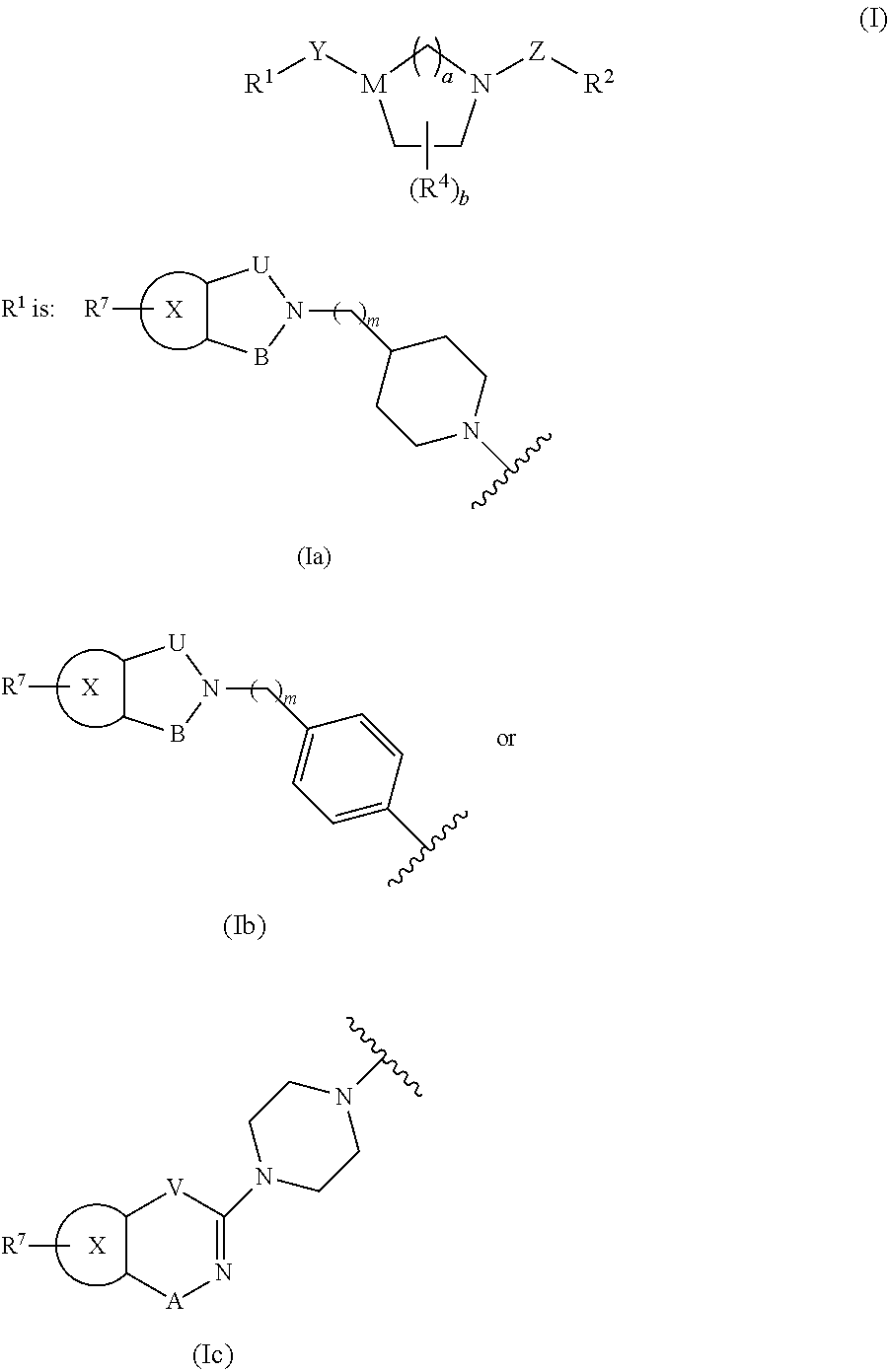Bicyclic Heterocylic Derivatives and Methods of Use
a bicyclic heterocylic and derivative technology, applied in the field of new drugs, can solve the problems of increased and premature morbidity and mortality, increased risk of macrovascular and microvascular complications in diabetic patients, and increased plasma insulin levels
- Summary
- Abstract
- Description
- Claims
- Application Information
AI Technical Summary
Benefits of technology
Problems solved by technology
Method used
Image
Examples
example 1
Preparation of Compound 1
[0207]
Step 1—Synthesis of Compound 1c
[0208]
[0209]Sodium triacetoxyborohydride (2.57 g, 12.12 mmol, 1.8 eq) was added to a stirred solution of compound 1b (1.75 g, 8.78 mmol, 1.3 eq) and compound 1a (1.07 g, 636 mmol) in dry DCM (200 mL) at room temperature, and the resulting mixture was allowed to stir for 15 hours. Then the mixture was diluted with DCM and treated with saturated aqueous K2CO3 solution. The layers were separated and the aqueous was extracted with DCM. The combined organic extracts were dried over MgSO4, filtered and concentrated in vacuo to provide a residue that was purified using flash column chromatography on silica gel (DCM:0.4N NH3 in MeOH 95:5) to provide compound 1c (1.71 g, 74%) as a yellow oil.
Step 2—Synthesis of Compound 1d
[0210]
[0211]A solution of compound 1c (1.71 g, 6.76 mmol) in a mixture of dichloromethane (90 mL) and trifluoroacetic acid (15 mL) was allowed to stir at room temperature for 2 hours. The reaction mixture was the...
example 2
Preparation of Compound 2
[0216]
[0217]Step 1—Synthesis of Compound 2b
[0218]Manganese (IV) oxide (4.6 g, 52.9 mmol, 8.0 eq) was added to a stirred solution of compound 2a in dry chloroform (20 mL) and the resulting mixture was allowed to stir for 144 hours at room temperature. The reaction mixture was filtered and concentrated in vacuo to provide compound 2b (781 mg, 62%) as yellow crystals.
Step 2—Synthesis of Compound 2c
[0219]Using the method described in Step 2 of Example 1, compound 2b was converted to compound 2e.
Step 3—Synthesis of Compound 2d
[0220]
[0221]Triethylamine (6.9 mL, 49.5 mmol, 5.0 eq), formic acid (1.8 mL, 49.5 mmol, 5.0 eq) and bis-1,1′(diphenylphosphino) ferrocenedichloro palladium (II) (520 mg, 0.64 mmol, 6.7 mol %) were added to a stirred solution of compound 2e (2.996 g. 9.52 mmol) in dry DMF (50 mL) at room temperature. The resulting mixture was heated at 70° C. and allowed to stir at this temperature for 2.5 hours, then the reaction mixture was cooled to room te...
example 3
Preparation of Compound 3
[0225]
[0226]Step 1—Synthesis of Compound 3c
[0227]To a solution of compound 3b (4.0 g, 0.012 mol) and compound 3a (4.1 g, 0.035 mol) in DCM (200 mL) was added EDC (6.8 g, 0.035 mol), HOBt (4.8 g, 0.035 mol) and Et3N (3.6 g, 0.035 mol). The resulting reaction was allowed to stir at room temperature for 18 hours, then diluted with DCM, washed with 1N NaOH and brine, dried over MgSO4, filtered and concentrated in vacuo. The residue obtained was purified using flash column chromatography on silica gel (MeOH / DCM, 1:10) to provide compound 3c (3.9 g, 79%).
[0228]Step 2—Synthesis of Compound 3d
[0229]To a solution of compound 3c (2.0 g, 4.63 mmol) in DCM (20 mL) was added pyridine (1.3 mL, 16.2 mmol) and Dess-Martin peridinane (7.9 g, 11.6 mmol). The resulting reaction was allowed to stir at room temperature for 12 hours, then saturated aqueous NaHCO3 and saturated aqueous NaS2O3 was added and the resulting solution was allowed to stir for 20 minutes. The mixture was ...
PUM
| Property | Measurement | Unit |
|---|---|---|
| temperature | aaaaa | aaaaa |
| temperature | aaaaa | aaaaa |
| temperature | aaaaa | aaaaa |
Abstract
Description
Claims
Application Information
 Login to View More
Login to View More - R&D
- Intellectual Property
- Life Sciences
- Materials
- Tech Scout
- Unparalleled Data Quality
- Higher Quality Content
- 60% Fewer Hallucinations
Browse by: Latest US Patents, China's latest patents, Technical Efficacy Thesaurus, Application Domain, Technology Topic, Popular Technical Reports.
© 2025 PatSnap. All rights reserved.Legal|Privacy policy|Modern Slavery Act Transparency Statement|Sitemap|About US| Contact US: help@patsnap.com



